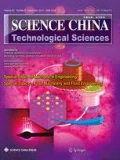Abstract
Dilute gas-particle turbulent flows over a backward-facing step are numerically simulated by Large Eddy Simulation (LES) for the continuous phase and Lagrangian particle trajectory method for the particle phase. Predicted results of mean velocities and fluctuating velocities of both phases agree well with the experimental data, and demonstrate that the main characteristics of the flow are accurately captured by the simulations. Characteristics of separation and reattachments as well as essential features of the coherent structure are obtained, in which the processes of vortex roll up, growth, pairing and breaking up are shown in details. Particle dispersions are then investigated through particles’ instantaneous distributions in coherent structure as well as the mean and fluctuating properties of particle number density (PND). The predicted mean PND agree well with experiment results. For small particles, the instantaneous distributions show much preferential concentration, while their mean PND shows more uniform distribution in downstream region. On the contrary, for large particles, their instantaneous distributions are much uniform (without clear preferential concentration) due to less effect of large eddy coherent, while their mean PND across the section is not uniform for more particles are distributed in the main flow region. The preferential concentration of particles by the large-scale eddies can lead to a high fluctuating PND.
Similar content being viewed by others
References
Crowe C T, Chung J N, Troutt T R. Particle mixing in free shear flows. Prog Energy Combust Sci, 1988, 14(3): 171–194
Tang L, Wen F, Yang Y, et al. Self-organized particle dispersion mechanism in a plane wake. Phys Fluids, 1992, A 4(10): 2244–2251
Ling W, Chung J N, Troutt T R, et al. Direct numerical simulation of a three-dimensional temporal mixing layer with particle dispersion. J Fluid Mech, 1998, 358: 61–85
Wallner E, Meiburg E. Vortex pairing in two-way coupled particle laden mixing layers. Int J Multiph Flow, 2002, 28(2): 325–346
Chein R, Chung J N. Simulation of particle dispersion in a two-dimensional mixing layer. Aiche J, 1988, 34(6): 946–954
Chung J N, Troutt T R. Simulation of particle dispersion in an axisymmetric jet. J Fluid Mech, 1988, 186: 199–222
Hansell D, Kennedy I M, Kollmann W. A simulation of particle in a turbulent jet. Int J Multiph. Flow, 1992, 18(4): 559–576
Crowe C T, Chung J N, Troutt T R. Particle interaction with vortices. In: Green S I, ed. Fluid Vortices. Dordrecht: Kluwer Academic Publishers, 1995. 829–861
Brooke J W, Hanratty T J, McLaughlin J B. Free-flight mixing and deposition of aerosols. Phys Fluids, 1994, A6(10): 3404–3415
He Z, Liu Z H, Chen S, et al. Effect of particle inertia on temperature statistics in particle-laden homogeneous isotropic turbulence. Sci China Ser E-Tech Sci, 2006, 49 (2): 210–221
Wang Q, Squires K D. Large eddy simulation of particle deposition in a vertical turbulent channel flow. Int J Multiph Flow, 1996, 22(4): 667–683
Kulick J D, Fessler J R, Eaton J K. Particle response and turbulence modification in fully developed channel flow. J Fluid Mech, 1994, 277: 109–134
Eaton J K, Johnston J P. An experimental study of the flow and structure behind a backward-facing step. Stanford University Report, 1980, MD-39
Wu X, Squires K D, Wang Q. Extension of the fractional step method to general curvilinear coordinate systems. Numer Heat Tranf B-Fundam, 1995, 27(2): 175–194
Kravchenko A G, Moin P. On the effect of numerical errors in large eddy simulations of turbulent flows. J Comput Phys, 1997, 131(2): 310–322
Dai Y, Kobayashi T, Taniguchi N. Large eddy simulation of plane turbulent jet flow using a new outflow velocity boundary condition. JSME Int J Ser B-Fluids Therm Eng, 1994, 37(2): 242–253
Fessler J R, Eaton J K. Turbulent modification by particle in a backward-facing step flow. J Fluid Mech, 1999, 394: 97–117
Author information
Authors and Affiliations
Corresponding author
Additional information
Supported by the National Natural Science Foundation of China (Grant Nos. 19972036, 50172067) and the Research Committee of The Hong Kong Polytechnic University (Grant No. A-DP99)
Rights and permissions
About this article
Cite this article
Zhang, H., Wang, B., Chan, C. et al. Large Eddy Simulation of a dilute particle-laden turbulent flow over a backward-facing step. Sci. China Ser. E-Technol. Sci. 51, 1957–1970 (2008). https://doi.org/10.1007/s11431-008-0154-1
Received:
Accepted:
Published:
Issue Date:
DOI: https://doi.org/10.1007/s11431-008-0154-1




